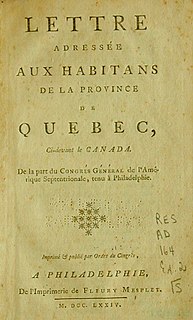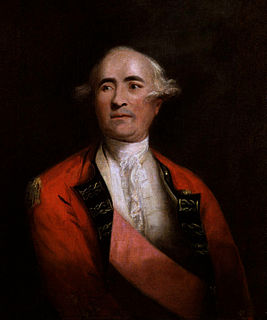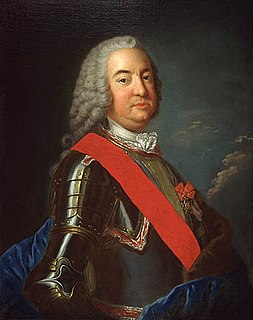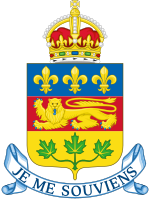
The Quebec Act 1774, formally known as the British North America (Quebec) Act 1774, was an act of the Parliament of Great Britain setting procedures of governance in the Province of Quebec. The act's principal components were:

Guy Carleton, 1st Baron Dorchester, known between 1776 and 1786 as Sir Guy Carleton, was an Anglo-Irish soldier and administrator. He twice served as Governor of the Province of Quebec, from 1768 to 1778, concurrently serving as Governor General of British North America in that time, and again from 1785 to 1795. The title Baron Dorchester was created on 21 August 1786.

The Invasion of Quebec was the first major military initiative by the newly formed Continental Army during the American Revolutionary War. The objective of the campaign was to seize the Province of Quebec from Great Britain, and persuade French-speaking Canadiens to join the revolution on the side of the Thirteen Colonies. One expedition left Fort Ticonderoga under Richard Montgomery, besieged and captured Fort St. Johns, and very nearly captured British General Guy Carleton when taking Montreal. The other expedition, under Benedict Arnold, left Cambridge, Massachusetts and traveled with great difficulty through the wilderness of Maine to Quebec City. The two forces joined there, but they were defeated at the Battle of Quebec in December 1775.

The Province of Quebec was a colony in North America created from Canada by Great Britain in 1763 after the Seven Years' War. During the war, British forces conquered the French colony. As part of terms of the Treaty of Paris peace settlement, France gave up its claim to Canada and negotiated to keep the small but rich sugar island of Guadeloupe instead. By Great Britain's Royal Proclamation of 1763, Canada was renamed the Province of Quebec. The new British province extended from the coast of Labrador on the Atlantic Ocean, southwest through the Saint Lawrence River Valley to the Great Lakes and beyond to the confluence of the Ohio and Mississippi Rivers. Portions of its southwest were later ceded to the young United States in the Treaty of Paris (1783) at the conclusion of the American Revolution, although the British maintained a military presence there until 1796. In 1791, the territory north of the Great Lakes was reorganised and divided into Lower Canada and Upper Canada.

The Letters to the inhabitants of Canada were three letters written by the First and Second Continental Congresses in 1774, 1775, and 1776 to communicate directly with the population of the Province of Quebec, formerly the French province of Canada, which had no representative system at the time. Their purpose was to draw the large French-speaking population to the American revolutionary cause. This goal ultimately failed, and Quebec, along with the other northern provinces of British America, remained loyal to Britain. The only significant assistance that was gained was the recruitment of two regiments totalling not more than 1,000 men.

Pierre du Calvet was a Montreal trader, justice of the peace, political prisoner and epistle writer of French Huguenot origin.

Sir Frederick Haldimand, KB was a military officer best known for his service in the British Army in North America during the Seven Years' War and the American Revolutionary War. From 1778 to 1786, he served as Governor of the Province of Quebec, during which time he oversaw military operations against the northern frontiers in the war, and engaged in ultimately fruitless negotiations to establish the independent Vermont Republic as a new British province. His administration of Quebec was at times harsh, with the detention of numerous political dissidents and agitators.

Pierre de Rigaud de Vaudreuil de Cavagnial, marquis de Vaudreuil was a Canadian-born colonial governor of French Canada in North America. He was governor of French Louisiana (1743–1753) and in 1755 became the last Governor-General of New France. In 1759 and 1760 the British conquered the colony in the Seven Years' War.
The constitutional history of Canada begins with the 1763 Treaty of Paris, in which France ceded most of New France to Great Britain. Canada was the colony along the St Lawrence River, part of present-day Ontario and Quebec. Its government underwent many structural changes over the following century. In 1867 Canada became the name of the new federal Dominion extending ultimately from the Atlantic to the Pacific and the Arctic coasts. Canada obtained legislative autonomy from the United Kingdom in 1931, and had its constitution patriated in 1982. Canada's constitution includes the amalgam of constitutional law spanning this history.

Philippe de Rigaud, Marquis de Vaudreuil was a French military officer who served as Governor General of New France from 1703 to 1725, throughout Queen Anne's War and Father Rale's War.

The Battle of Fort Niagara was a siege late in the French and Indian War, the North American theatre of the Seven Years' War. The British siege of Fort Niagara in July 1759 was part of a campaign to remove French control of the Great Lakes and Ohio Valley regions, making possible a western invasion of the French province of Canada in conjunction with General James Wolfe's invasion to the east.

Fleury Mesplet was a French-born Canadian printer best known for founding the Montreal Gazette, Quebec's oldest daily newspaper, in 1778.

Île aux Noix is an island on the Richelieu River in Quebec, close to Lake Champlain. The island is the site of Fort Lennox National Historic Site of Canada. Politically, it is part of Saint-Paul-de-l'Île-aux-Noix.

Fort Chambly is a historic fort in La Vallée-du-Richelieu Regional County Municipality, Quebec. It is designated as a National Historic Site of Canada. Fort Chambly was formerly known as Fort St. Louis. It was part of a series of five fortifications built along the Richelieu River to protect travellers on the river from the Iroquois. The region is informally known as la Vallée-des-Forts.

Michel-Eustache-Gaspard-Alain Chartier de Lotbinière, 2nd Marquis de Lotbinière, though to keep political favour with the British he never used the title. He was seigneur of Vaudreuil, Lotbinière and Rigaud. He was the Speaker of the House of Commons in Lower Canada who saw to it that the French language was recognised as equal to English in the Quebec Parliament, where a painting of him giving the speech still hangs above the Speaker's chair.
François-Marie Picoté, sieur de Belestre II was a colonial soldier for both New France and Great Britain.

Michel-Alain Chartier de Lotbinière, 1st Marquis de Lotbinière (1723–1798), Seigneur of Vaudreuil, Lotbinière and Rigaud, Quebec etc. In 1757, on his advice at the Siege of Fort William Henry, the Marquis de Montcalm successfully attacked Fort William Henry. In 1758, Lotbinière again advised Montcalm to await rather than attack the British Army, at Fort Carillon, the fort that Lotbinière had built, which led to the French victory at the Battle of Carillon. In 1784, Louis XVI of France created Lotbinière a Marquis, the only Canadian by family and birth to have attained that rank, and the last such creation made by Louis XVI. He was the last private owner of Château Vaudreuil in Montreal.

François-Pierre de Rigaud de Vaudreuil was a soldier, fur trader, seigneur and administrator in New France. He served as governor of Trois-Rivières from 1749 to 1757 and governor of Montreal from 1757 to 1760.
Jacob Bayley was an officer, first serving with the British in the French and Indian War, then later as a brigadier general in the Continental Army during the American Revolutionary War.

The British military regime in New France was the British army's occupation of New France from 1759 to 1763 as part of its Conquest of New France. Between 1760, following the surrender of Montreal, and 1763, when the colonial province of Quebec (1763-1791) was created, a temporary military regime administered the colony of Canada.

















